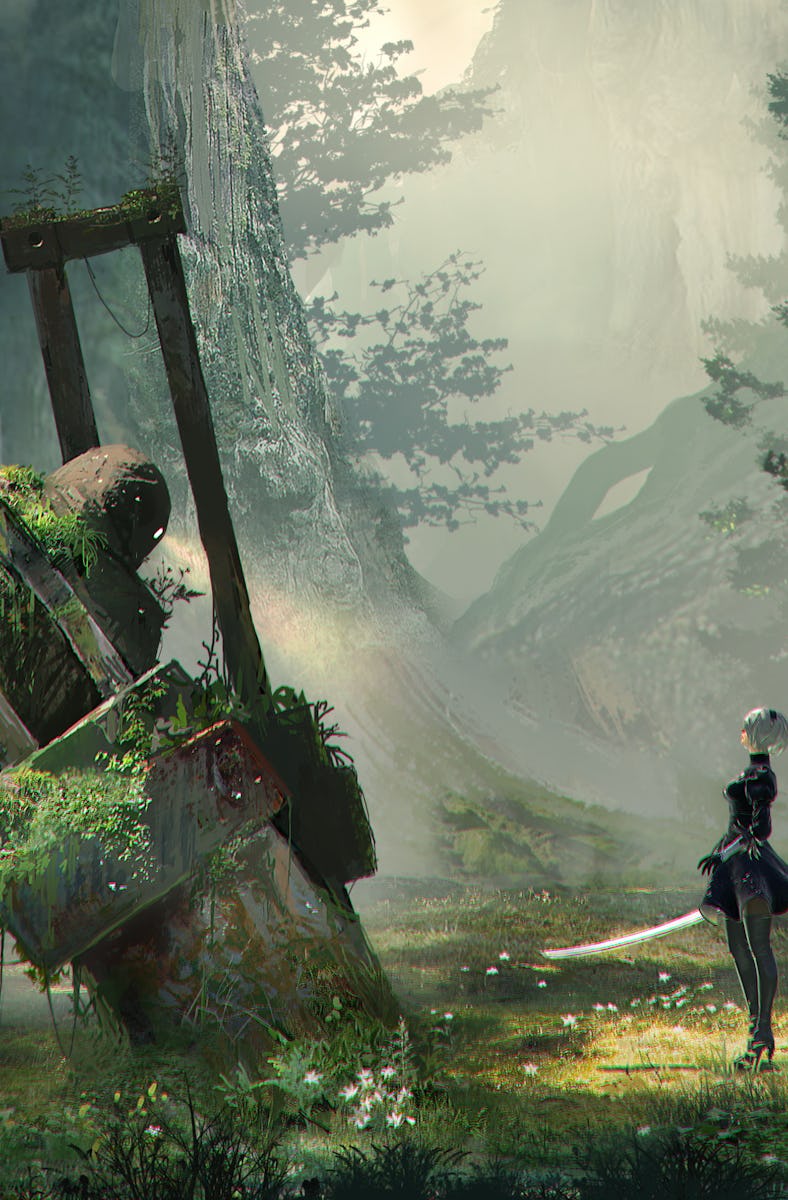6 Years Ago, Square Enix Released a Modern Masterpiece
Breaking the invisible wall.

After a handful of hours destroying Machine Lifeforms in NieR: Automata, the player will stumble onto a village full of Machine Lifeforms waving white flags of surrender in response to your arrival, in hopes that you won’t murder the entire village. “We are not your enemy,” they will say to you.
It’s a striking moment that shocks the player out of their natural response to hack and slash endlessly through a game, and one that speaks to the game's unique outlook on the medium of video games and how stuck in its ways it is. Six years later, moments like this linger in our minds, proving that NieR: Automata is a timeless and unmatched masterpiece.
Automata’s combat is varied and exciting.
Yoko Taro, the creator of the Drakengard and NieR franchises, has always been an oddball in the gaming industry. Known for his love of beer, deadpan humor, and never showing his face, Taro has sought to make games just as weird as the persona he inhabits. Because of this, the majority of his games have remained cult hits at best — until NieR: Automata.
Tangentially connected to the overarching universe of Drakengard and the original NieR, Automata is a game about android soldiers in a distant post-apocalyptic Earth fighting an endless conflict in hopes of making the planet safe for humanity (who are holed up on the Moon) to return. Directed by Taro and published by Square Enix, the game was developed by action masters PlatinumGames.
While combat has the signature PlatinumGame shine when it comes to the hack-and-slash sections, part of the appeal of Automata is how the game shifts and reshapes itself to include a myriad of different game styles all in one package. In addition to hack-slash, the game incorporates elements of bullet hell and text adventure games. Automata plays like a survey of video games as a medium and crams it all together in one messy package that delights.
But the true standout of NieR: Automata is the narrative of androids 2B, 9S, and A2.
Different perspectives reveal a complex narrative.
At its simplest, Automata is a game about the dehumanization of individuals and society at large due to perpetual conflict. Examining the cycle of violence is a bit of a tired trope that can often feel like prestige bait. But this basic summary does not paint an accurate picture of the depth that Automata goes to when investigating these themes.
The question of who in the world of Automata has humanity is one that the game very clearly makes its stance known early on. The cyclical nature of the seemingly pointless missions that the androids and the council of humanity embark on is the most machine and inhuman thing in this world.
In a world where no real humans interact, we see the humanity in the quiet moments where the budding culture of the Machine Lifeforms is revealed. Living tableaus of Machine Lifeorms trying to conceive children or performing Shakespeare demonstrates a sense of living that the androids lack.
Like previous Taro games, Automata features multiple endings and routes that reveal aspects of the main narrative — further still, Automata tells the story from three different perspectives. The execution of Automata’s themes through this winding perspective-shifting and genre-bending narrative culminates in a truly standout finale that asks the player to sacrifice something real. It is the pinnacle of Taro’s body of work that speaks to what he sees as the purpose of video games.
NieR: Automata breaks new ground for the medium of video games to affect real change.
Every Taro is politically charged, and each stands as a response to larger issues in the world. The original NieR was a response to 9/11 with Taro observing society and expressing his reaction. “You don’t have to be insane to kill someone,” Taro said during a 2014 GDC panel. “You just have to think you are right.” Taro sees the potential of games to “emotionally affect the player in an extreme or an otherwise substantial way.”
In 2014, Taro described the idea of an invisible wall that held gaming back from breaking into a nebulous grey zone that held the fullest potential of the medium, but he believed he had personally failed to help games break past that invisible wall. Instead, Taro believed games remained bound by certain expectations and conventions put in place. Development on NieR: Automata started that same year.
Three years after this GDC talk, NieR: Automata was released to critical acclaim. Thanks to a combination of innovative yet sometimes meaningfully abrasive combat and narrative design, Taro had managed to break through that invisible wall into the grey area.
To this day there is nothing else like NieR Automata.